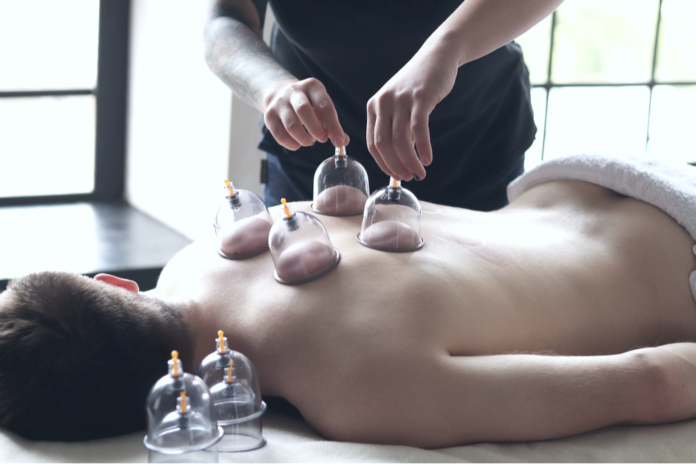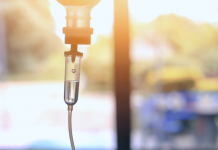As western medicine becomes more holistic, alternative therapies are becoming more popular. Cupping is one such emerging modality with numerous health benefits.
Learn all about cupping and how it can fit into a healthy lifestyle here!
What Is Cupping?
A traditional Chinese and Middle Eastern medicine, cupping is an ancient healing practice, usually utilized to relieve pain. It entails placing cups on the skin to create suction, which then increases blood flow to that area. In turn, the enhanced blood flow may relieve muscle tension, promote cell repair and help form new connective tissues and create new blood vessels in the tissue.
Interestingly, the body treats the “cupped” areas like an injury. Thus, it sends additional blood and fluid to the area to stimulate a natural healing process. Some people further propose that cupping clears pores and releases toxins, although more research is warranted.
Spiritual proponents of cupping, such as Taoists, believe that this alternative practice also helps balance the flow of “qi” or energy known as yin and yang throughout the body. Yin and yang can also be considered positive and negative energy, respectively. In fact, the famous Taoist herbalist and alchemist, Ge Hong, was supposedly the first to practice this technique.
Different Types of Cupping
Cupping methods include dry and wet forms and may involve briefly moving the cups to stretch or massage different areas of the body. Anywhere from three to seven cups are placed on affected or desired parts of the body such as the back or legs.
During dry cupping, a provider heats the inside of each cup with an alcohol-soaked cotton ball that is set aflame. The created heat then sends oxygen out of the cup, creating a sort of vacuum, and this force pulls the skin into the cup. Some providers may use a suction device to suck the air from the cups and this method usually requires five to ten minutes.
In wet cupping method which is less popular, a needle lightly punctures the skin before and sometimes, after cupping as well. Then, toxins leave the body through the puncture wounds and cups are only placed for a couple minutes before blood is drawn.
Who Performs Cupping?
Numerous types of professionals perform cupping and the most common include acupuncturists, chiropractors, medical doctors, physical therapists and of course, massage therapists.
Worth noting, cupping falls under the scope of practice of acupuncture and Traditional Chinese Medicine, so check out local acupuncturists or Chinese medicine doctors first.
Benefits of Cupping
Most often, cupping is utilized to treat muscle soreness and aches. Many people remember Michael Phelps covered in cupping marks at the 2016 Olympics, and it is likely he was using this technique to help his muscles recover quicker and better!
The other main benefits include:
- Increased blood flow to areas where cups are placed
- Balances energy throughout the body
- Corrects imbalances arising from injury or illness
- Potential increased range of motion
- Decreased perception of pain
However, cupping has also been anecdotally shown to improve skin diseases like acne or hives, lower cholesterol, reduce migraines and enhance immune function.
Risks and Side Effects
Beyond the infamous cup marks associated with the technique, there are not too many side effects and most practitioners deem it generally safe.
However, after treatment the skin surrounding the rim of the cup may become irritated and/or there may be pain at the incision sites.
Some practitioners say their clients will feel dizzy or lightheaded during or after the treatment. To prevent this, drink plenty of water before and after the procedure and consume a nutrient-dense meal shortly after.
Additional but uncommon side effects are infection around a cup site, scarring of the skin and bruising. Qualified professionals who take proper precautions easily prevent these.
Furthermore, there are certain groups who should avoid cupping and these include children under four years of age, seniors, pregnant women, those taking blood-thinning medication, and anyone with a sunburn, wound, skin ulcer, internal organ disorders, and general skin irritation.
Specific Conditions Cupping May Benefit
Nowadays, there is a long laundry list of conditions cupping may benefit. While most of them involve some type of pain or ache, there are a few seemingly unrelated conditions on this list as well.
- Acne
- Arthritis including rheumatoid arthritis
- Back, neck, knee and shoulder pain relief
- Breathing problems like asthma and congestion
- Carpal tunnel syndrome
- Cervical spondylosis
- Facial paralysis
- High Blood pressure and cholesterol
- Intestinal distress and disorders like IBS, bloating and Chrons
- Lumbar disc herniation
- Migraines and headaches
- Shingles
- Sports injuries and for performance
The Takeaway
Cupping is an alternative therapy with roots in Chinese medicine. Best known for easing aches and pains, “cups” create a skin suction that leads to increased blood flow to the area. As a result, it promotes cellular repair and increased connective tissue. Other proponents of this technique believe it helps balance the natural energy of the body as well.
Generally considered safe, it is always best to check with a medical doctor beforehand!
References:
Cupping: Back Pain, Neck Pain, Types, Benefits, Treatment. Cleveland Clinic. Published August 19, 2020. my.clevelandclinic.org/health/treatments/16554-cupping.
Marcin A. Cupping Therapy: Uses, Benefits, and More. Healthline. Updated January 3, 2019. www.healthline.com/health/cupping-therapy.
Shmerling RH. What Exactly Is Cupping? Harvard Health Blog. Updated June 23, 2020. www.health.harvard.edu/blog/what-exactly-is-cupping-2016093010402.
Wong C. Cupping Therapy Overview, Benefits, and Side Effects. Verywell Health. Reviewed April 6, 2020. www.verywellhealth.com/cupping-for-pain-88933.









